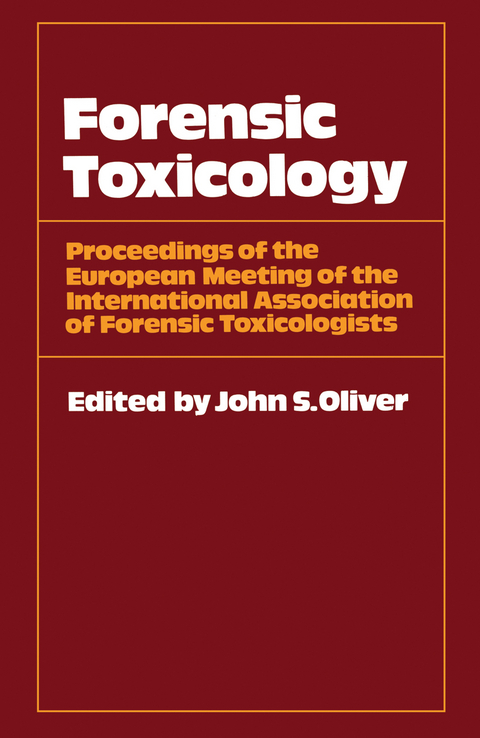
Forensic Toxicology
Springer-Verlag New York Inc.
978-1-4684-1480-6 (ISBN)
Forensic toxicology has progressed rapidly and diversified greatly in recent years. The members of the International Association of Forensic Toxicologists provide a valuable service through the association's bulletin. In its pages members hear of new poisons as they are encountered and the analytical techniques used to deal with them. There is a wealth of information in the form of case reports which is used to assist with the interpretation of the results. Each year the members have the opportunity of meeting in Europe. In 1979 the chosen venue was the University of Glasgow and the meeting was hosted by the Department of Forensic Medicine and Science. The department was established by Royal Charter in 1839 within a few years of the beginning of the modern approach to toxicology. In those early years the function of the department was to teach forensic medicine and toxicology. Today the department has become a recognised centre for the teaching of forensic medicine. The toxicology section has expanded greatly to provide the best forensic and environmental toxicology in Scotland. Inorganic analytical facilities are available for the investigation of metallic poisons by atomic absorption spectrometry, neutron activation analysis, X-ray fluorescence and anodic stripping voltametry. Organic analytical toxicology is pursued using gas chromatography, high performance liquid chromatography, immunoassays, and gas chromatography mass spectrometry. Apart from the normal research and routine investigations of a toxicological laboratory the department specialises in the investigation of fire related deaths, solvent abuse (glue sniffing) and trace element studies in human subjects.
1. Traces and Tracers — The Limits of Toxicology.- 2. A Rapid 2D TLC Screening Procedure for Drugs in Cases of Acute Drug Overdosage.- 3. Selection of Methods for Systematic Toxicological Analysis.- 4. Immunoassays in Forensic Toxicology.- 5. Insulin Murders: Isolation and Identification by Radioimmunoassay After Several Months of Inhumation.- 6. Clozapin, a Fatal Case.- 7. The Detection of Heavy Metals from Biological Material by Gas-liquid-chromatography via the Diethyldithiocarbamates.- 8. Determination of 8-methoxypsoralen in Human Serum and Suction Blister Fluid.- 9. Isolation of Drugs from Blood and Tissue Homogenates using Thin Channel Ultrafiltration.- 10. Analysis of Autopsy Samples for the Detection of 2,3,7,8-tetrachlorodibenzo-p-dioxin by High Resolution GC-MS.- 11. Rapid Analytical Method for Alcohol in Biological Fluids Using the Alcolmeter AE-Dl.- 12. Fuel Cell Measurement of Breath/blood Alcohol.- 13. Extractive Dialysis.- 14. A Road Traffic Act Drug Screening System — A Survey of Results.- 15. Toxicological Determination of Heroin and Morphine in Urine and Blood of Man.- 16. Analysis and Disposition of Dextromoramide in Body Fluids.- 17. GLC and TLC of Some Pethidine-like Narcotics and their Metabolites.- 18. The Abuse of Preparations containing Dipipanone and Cyclizine; Analytical Aspects and their Interpretation.- 19. A Benzodiazepine Survey of Urine Samples Collected for the Purposes of the Road Traffic Act.- 20. A Specific Method for the Analysis of Buformin in Pre- and Post-mortem Human Material.- 21. The Comparison of TLC with GLC and GC/MS as well as TLC/GLC as Screening Methods for Synthetic, Chemical Stimulating Laxatives in Case of Abuse.- 22. The Screening of Pesticides in Forensic Toxicology.- 23. The Relevance of Plasma ParaquatAssays.- 24. Illicit Methadone — Laboratories in Berlin.- 25. Analytical Estimation of Indomethacin in Plasma by Gas Chromatography — Mass Fragmentography.- 26. On-line Identification Program of Poisonous and Hallucinogenic Mushrooms.- 27. Identification of Amphetamine, Mefenorex and Fencanfamin in Three Cases of Doping.- 28. The Detection of Coumarin Anticoagulants in Biological Fluids by Gas Liquid Chromatography-Mass Spectrometry.- 29. A Simple Gas-Liquid Chromatographic Assay for the Measurement of a New Antiarrhythmic Drug Lorcainide and its Metabolite Norlorcainide in Plasma.- 30. Rapid High-performance Liquid Chromatographic Method for the Measurement of Temazepam in Blood-plasma or Serum.- 31. Mercury Intoxications During Application of Pharmaceutical Preparations.- 32. Experience with Enzymatic Deproteination in General Toxicological Case Work.- 33. The Analysis of Volatiles in Blood from Fire Fatalities.- 34. Chromatographic Detection of Some Drugs of Toxicological Interest Using a Method for Amphetamine Identification.- 35. The Analysis of Blood in Cases of Suspected Solvent Abuse (“glue sniffing”) with a Review of Results Obtained During the Period October 1977 to July 1979.- 36. The Detection of Drugs in Greyhound Urine by EMIT and TLC.- Author Index.
| Erscheint lt. Verlag | 18.2.2012 |
|---|---|
| Zusatzinfo | 51 Illustrations, black and white; 320 p. 51 illus. |
| Verlagsort | New York, NY |
| Sprache | englisch |
| Maße | 140 x 216 mm |
| Themenwelt | Schulbuch / Wörterbuch |
| Medizin / Pharmazie ► Medizinische Fachgebiete ► Pharmakologie / Pharmakotherapie | |
| Medizin / Pharmazie ► Pharmazie | |
| Studium ► 2. Studienabschnitt (Klinik) ► Pharmakologie / Toxikologie | |
| Studium ► 2. Studienabschnitt (Klinik) ► Rechtsmedizin | |
| Naturwissenschaften | |
| Sozialwissenschaften | |
| Schlagworte | Absorption • Environment • Research • Sorption • Toxicology |
| ISBN-10 | 1-4684-1480-1 / 1468414801 |
| ISBN-13 | 978-1-4684-1480-6 / 9781468414806 |
| Zustand | Neuware |
| Haben Sie eine Frage zum Produkt? |
aus dem Bereich


